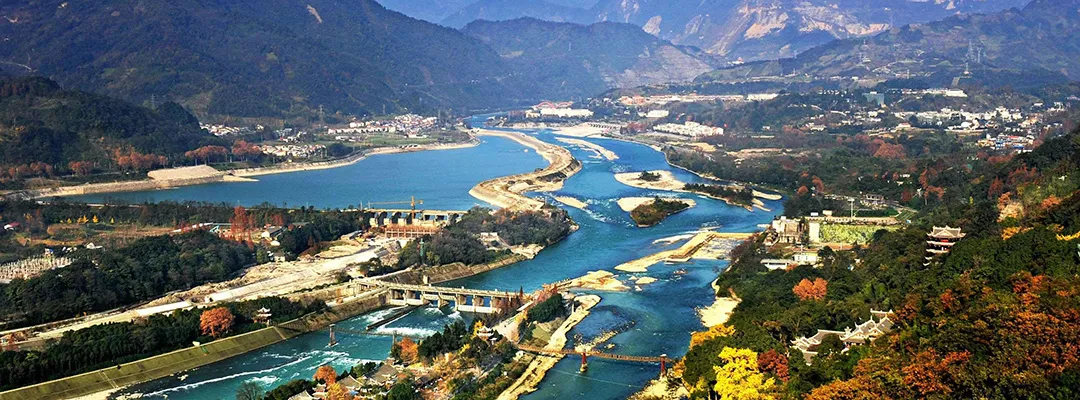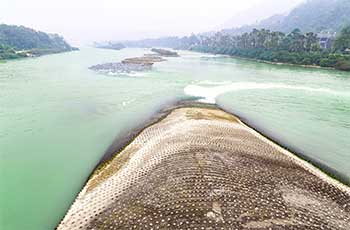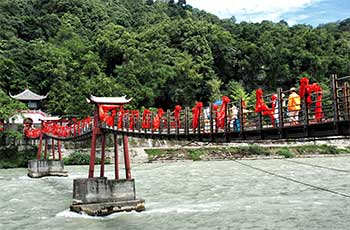Dujiangyan Irrigation System

The Dujiangyan Irrigation System is a major project of equal significance with the Great Wall in the history of Chinese civilization. The weir as a grand water conservancy project features water diversion without a dam, and is the only one that has survived through time and enjoys the longest history worldwide. It still plays a major role today. The weir is composed of the Yuzui Water Diversion Dam, Feishayan Spillway and Baopingkou Water Inlet, which eliminates floods and turns Chuanxi Plain into the beautiful and affluent Land of Plenty.
- Chinese name: 都江堰 Dū Jiāng Yàn
- Built in 256 BC
- Duration: 3-4 hours
- Entrance fee: RMB 90 per person
- Opening hours: 08:00-17:30 (Slack season: December 1st – March 1st); 08:00-18:00 (Busy season: March 2nd – November 30th)
- Address: Dujiangyan City, Chengdu, China
- Best time to visit: all year around
- How to get there: from Dujiangyan City, take Bus 1, 4 or the shuttle bus of the scenic area
Highlights of Dujiang Scenic Spot
1. Baopingkou (Bottle Neck)
Baopingkou is the first water conservancy project that can be seen when you get into the Dujiangyan Scenic Spot. It is in fact a ditch less than 20 m wide dug by Li Bing. However, as the throat that controls the water flow from Neijiang River to Chengdu Plain, it plays a vital role in the strict control of water volume. This site is in the shape of a bottleneck when looked down on from the sky, thus gaining its name.
 Yuzui (fish month type dividing dike
Yuzui (fish month type dividing dike The top of Dragon Taming Temple is the best place to look down over the grand vista of torrential water passing through Baopingkou. The crystal and running water in Minjiang River reminds you of the wisdom of our ancestors.
2. Yuzui (fish mouth type dividing dike)
Yuzui is short for Yuzui Water Diversion Dam of Dujiang Weir. Located deep inside Dujiang Weir, Yuzui is essentially the grandest part that is worth visiting.
3. Feishayan (Fly Sand Dam)
Feishayan Spillway is the second largest project in Dujiang Weir. It functions cleverly in water diversion and desilting, though it seems to be nothing special. The scene is spectacular, particularly in summer when the water in Minjiang is abundant.
 Anlan Rope Bridge
Anlan Rope Bridge 4. Anlan Rope Bridge
Anlan Bridge in front of Er’wang Temple is one of five well-known ancient bridges in China, stretching over the water diversion spot between Neijiang River and Waijiang River.
Torrential water roars under the ancient Anlan Rope Bridge. Courageous visitors are encouraged to try crossing the bridge. Both sides of the Rope Bridge are very safe with good protection, although the bridge swings. Here is also an ideal chance for photo-taking. Please take care of your cameras and yourselves.
Experience Slow Life in Dujiangyan
- Try a relaxing life: Stay at some rural guesthouses along banks of the river. Sleep tight on hammocks in the forest, enjoying the relaxing slow life in Dujiangyan with the sunshine and a breeze.
- Night tour in Dujiangyan City: Entrance fee for Ancient Lidui Park is RMB 15 from 19:00—21:00. Here you can experience something different from that of the day. There are performances of tea art, ancient music, and singing and dancing. Visitors who want to have fun can enjoy Dujiangyan beer festivals from May to October and try to experience the night life along the Night Beer Corridor beside Minjiang River.
Drop us a line and we'll connect you with the top China expert in no time!